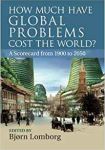How Much have Global Problems Cost the World?: A Scorecard from 1900 to 2050 by Bjorn Lomborg (Editor)
If you want to know how the world is doing, and get hard, comparable numbers to back it up, this is where to go… says Alix Peterson Zwane, Executive Director, Evidence Action and the Deworm the World Initiative, and former Senior Program Officer, Bill and Melinda Gates Foundation. Well, I’m not an expert and therefore can only speak from the viewpoint of a general reader.
| How Much have Global Problems Cost the World?: A Scorecard from 1900 to 2050 by Bjorn Lomborg (Editor) | |
|
| |
| Category: Politics and Society | |
| Reviewer: Trish Simpson-Davis | |
| Summary: This important reference book from the Copenhagen Consensus Centre attempts to evaluate the relative economic impact of ten key issues in world development. Discrete papers extrapolate from available data from the twentieth century to model projections to 2050. The editor, Bjørn Lomborg, evaluates the relative negative or positive economic effects of the ten topics, looking backwards and forwards, in a useful introduction. | |
| Buy? Maybe | Borrow? Yes |
| Pages: 401 | Date: October 2013 |
| Publisher: Cambridge University Press | |
| ISBN: 978-1107679337 | |
|
| |
The authors are leading researchers in their fields, and their papers have been critiqued by peer-reviewers. Each of the chapters reports the results of a modelling exercise, examining progress or decline in one of ten key areas, including armed conflict, trade barriers, malnutrition, air pollution, ecosystem and biodiversity, health, water and sanitation. Key economic, growth and other variables from credible sources provided a common set of data and assumptions, used in each study.
The chapter on climate change, for example, presents compelling projections. It is clear that poorer – mainly tropical - countries are the losers, both now and in the future, while temperate, developed nations have mainly benefitted until now, for example from reduced heating costs. However, projections suggest that this will change, with global warming becoming a negative cost for most nations, at some time after 2025.
I was also very interested in the huge cost to national economies of inadequate education for boys and girls. Associated with this is gender inequality, which ranges from the limited years of education often afforded to girls, to the continued imbalance in men and women in the workforce, and their relative earning power. It’s not so much that this information is new to me, rather that in stark black and white the cumulative results for sub-Saharan Africa are that much more compelling. Where developing countries in other parts of the world are improving year on year in one or other respect, Africa drags its heels in most of the (interrelated) areas scrutinised. It is now time for the Copenhagen Centre to return to its primary role of evaluating solutions to global challenges and priming governments on the most useful aid they can provide.
More than a hundred tables accompany the texts, providing telling examplars in this reference material, for commentators to use. The obvious limitation is, unsurprisingly, the lack of time-series data available (how on earth do you find enough information going back to 1900?). In fact, the study apparently sparked new and innovative data sets which are available on the Copenhagen Consensus Center website. Less obviously, a lack of researchers precluded inclusion of such important topics as credit and finance, population growth, corruption, politics and the depletion of resources including fossil fuels.
Clearly this is not a book to curl up with on a wet afternoon, since the research is written up in an academic format. Readership is likely to be limited to a quite specialist audience, by comparison with a journalistic style more accessible to the general public. However, Bjorn Lomborg overviews and evaluates the data emerging from each chapter in a useful and readable introduction which I would commend to the general reader. It is then down to individual choice which chapters are delved into, depending on how much time you have available.
Obviously, this is an authoritative study which will inform governments, NGO’s and media for some years. Therefore, instead of further reading, I am going to recommend a readable and engrossing book which also answers its own question, this time by two US journalists: Enough: Why the World's Poorest Starve in an Age of Plenty by Scott Kilman and Roger Thurow. If you are interested in the ineptitude of government aid, a series of slim books by a water development engineer tells it like it was in the 1970s, especially in Dust of the Danakil by Ian Mathie
Please share on: ![]() Facebook,
Facebook, ![]() Twitter and
Twitter and
![]() Instagram
Instagram
![]() You can read more book reviews or buy How Much have Global Problems Cost the World?: A Scorecard from 1900 to 2050 by Bjorn Lomborg (Editor) at Amazon.co.uk Amazon currently charges £2.99 for standard delivery for orders under £20, over which delivery is free.
You can read more book reviews or buy How Much have Global Problems Cost the World?: A Scorecard from 1900 to 2050 by Bjorn Lomborg (Editor) at Amazon.co.uk Amazon currently charges £2.99 for standard delivery for orders under £20, over which delivery is free.
![]() You can read more book reviews or buy How Much have Global Problems Cost the World?: A Scorecard from 1900 to 2050 by Bjorn Lomborg (Editor) at Amazon.com.
You can read more book reviews or buy How Much have Global Problems Cost the World?: A Scorecard from 1900 to 2050 by Bjorn Lomborg (Editor) at Amazon.com.
Comments
Like to comment on this review?
Just send us an email and we'll put the best up on the site.

